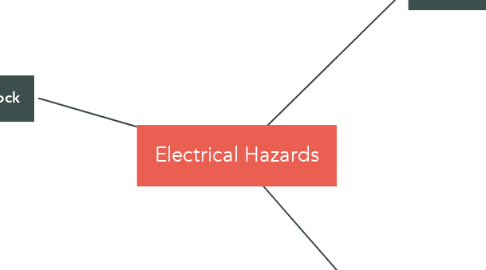
1. Electric Shock
1.1. Contact with live electrical components can also cause serious burns arising from the discharge of electrical energy
1.2. Health effect can includes
1.2.1. muscle spasm, shock, burns, palpitations, nausea and vomiting, collapse, fibrillation, unconsciousness, or death
1.3. Other risk includes
1.3.1. Fire and Explosion
1.4. Severity of depends on
1.4.1. Path of current through body
1.4.2. Amount of current flowing through body
1.4.3. Length of time the body is in circuit
1.4.3.1. Small to major burn on skin/body tissue
1.4.3.2. Kidney failure
1.4.3.3. brain damage
1.4.3.4. Ventricular fibrillation
1.4.3.5. Respiratory paralysis
2. Electric Currents
2.1. Currents : Flow of electricity
2.1.1. Electricity flowing in a circuit = Electrical current
2.1.2. Milliampere
2.1.2.1. 1 mA
2.1.2.1.1. Slight tingling sensation
2.1.2.2. 2 mA to 9 mA
2.1.2.2.1. A small shock
2.1.2.3. 10 mA to 24 mA
2.1.2.3.1. Your muscles can contract and cause you to ‘freeze’.
2.1.2.3.2. Burns are often apparent at the point of electrical contact.
2.1.2.4. 25 mA to 74 mA
2.1.2.4.1. Respiratory muscles can become paralyzed.
2.1.2.4.2. Entry and exit burns are often visible
2.1.2.5. 75 mA to 300 mA
2.1.2.5.1. Ventricular fibrillation.
2.1.2.5.2. Shock is usually fatal.
2.1.2.6. Above 300 mA
2.1.2.6.1. Death is likely.
2.1.2.6.2. Survivals will have severe burns to the skin, limbs and internal organs. Severely burnt limbs often need to be amputated.
2.2. Fundamental Rules of electricity
2.2.1. Rule 1: Electricity will only travel in a circuit
2.2.2. Rule 2: Electricity will always travel the path with the least resistance
2.2.3. Rule 3: The electricity will always try to travel to the ground
